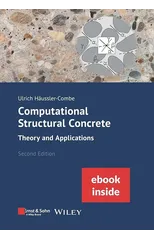Computational Structural Concrete
Theory and Applications, 2e (incl. eBook as PDF)
(Author) Ulrich Haussler-CombeConcrete is by far the most used building material due to its advantages: it is shapeable, cost-effective and available everywhere. Combined with reinforcement it provides an immense bandwidth of properties and may be customized for a huge range of purposes. Thus, concrete is the building material of the 20th century. To be the building material of the 21th century its sustainability has to move into focus. Reinforced concrete structures have to be designed expending less material whereby their load carrying potential has to be fully utilized. Computational methods such as Finite Element Method (FEM) provide essential tools to reach the goal. In combination with experimental validation, they enable a deeper understanding of load carrying mechanisms. A more realistic estimation of ultimate and serviceability limit states can be reached compared to traditional approaches. This allows for a significantly improved utilization of construction materials and a broader horizon for innovative structural designs opens up. However, sophisticated computational methods are usually provided as black boxes. Data is fed in, the output is accepted as it is, but an understanding of the steps in between is often rudimentary. This has the risk of misinterpretations, not to say invalid results compared to initial problem definitions. The risk is in particular high for nonlinear problems. As a composite material, reinforced concrete exhibits nonlinear behaviour in its limit states, caused by interaction of concrete and reinforcement via bond and the nonlinear properties of the components. Its cracking is a regular behaviour. The book aims to make the mechanisms of reinforced concrete transparent from the perspective of numerical methods. In this way, black boxes should also become transparent. Appropriate methods are described for beams, plates, slabs and shells regarding quasi-statics and dynamics. Concrete creeping, temperature effects, prestressing, large displacements are treated as examples. State of the art concrete material models are presented. Both the opportunities and the pitfalls of numerical methods are shown. Theory is illustrated by a variety of examples. Most of them are performed with the ConFem software package implemented in Python and available under open-source conditions. (incl. ebook as PDF)
Ulrich Haussler-Combe
Ulrich Haussler-Combe is a renowned German poet known for his emotionally charged and introspective works. His most famous poem, "Elegy of the Soul," beautifully captures the complexities of human experience and has cemented his reputation as a master of lyrical expression and profound insight in the literary world.

